MITS5002 - Waterfall Model Implementation in Large Scale Project
VerifiedAdded on 2023/04/23
|6
|1848
|188
Report
AI Summary
This report provides an analysis of the Waterfall model's implementation in large-scale development projects, using a case study approach focused on Ericsson AB. The research employs quantitative data analysis, including interviews and surveys, to identify issues in requirement engineering, development, and verification/validation phases. Key findings reveal challenges such as delays in testing, reduced project dynamicity, and extensive documentation. Despite its limitations, the report concludes that the Waterfall model can still perform efficiently, and the identified issues are often user-dependent. The analysis also sheds light on the increasing adoption of Agile methodologies as an alternative approach. Desklib offers a wealth of resources, including past papers and solved assignments, to support students in their academic endeavors.
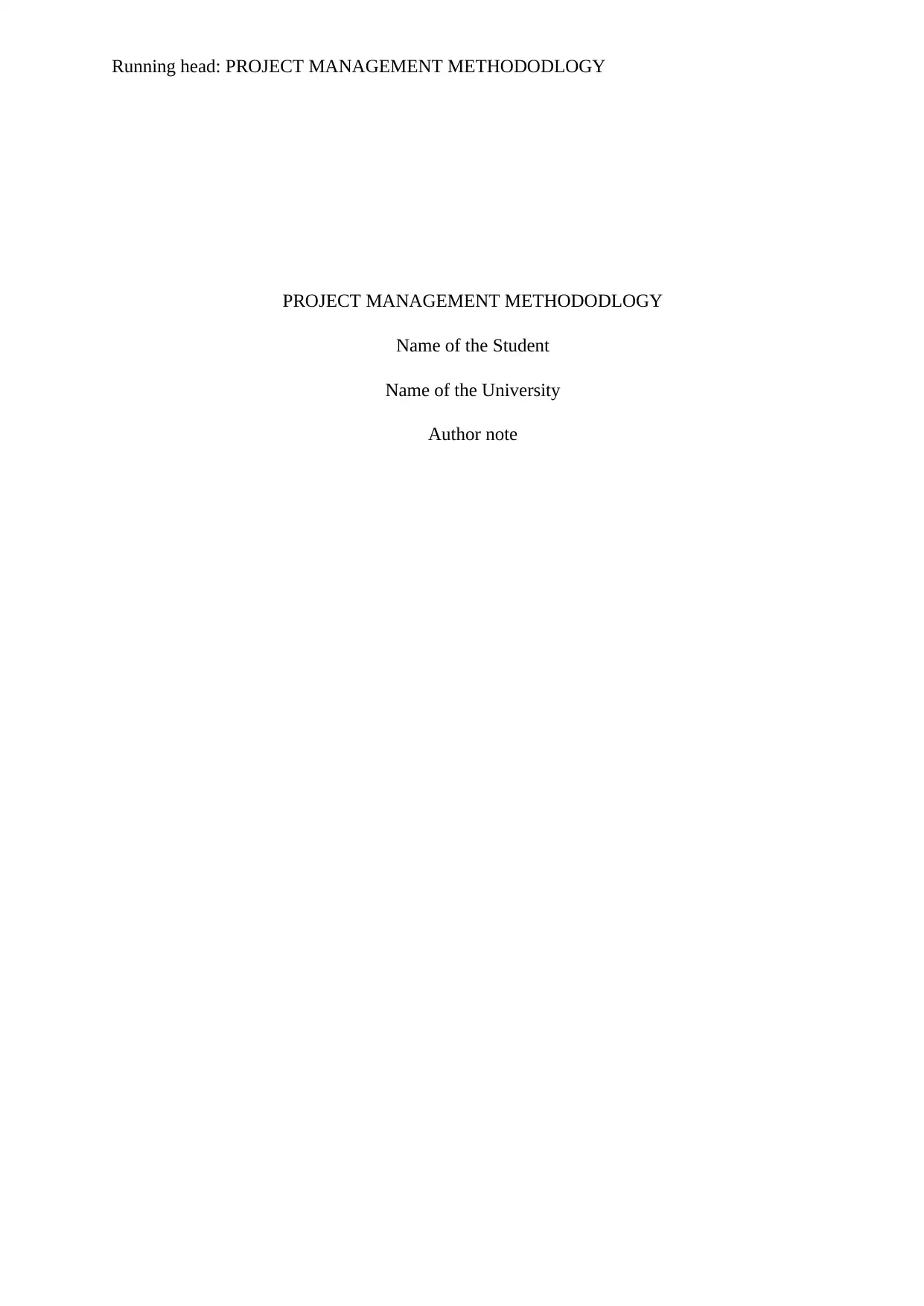
Running head: PROJECT MANAGEMENT METHODODLOGY
PROJECT MANAGEMENT METHODODLOGY
Name of the Student
Name of the University
Author note
PROJECT MANAGEMENT METHODODLOGY
Name of the Student
Name of the University
Author note
Paraphrase This Document
Need a fresh take? Get an instant paraphrase of this document with our AI Paraphraser
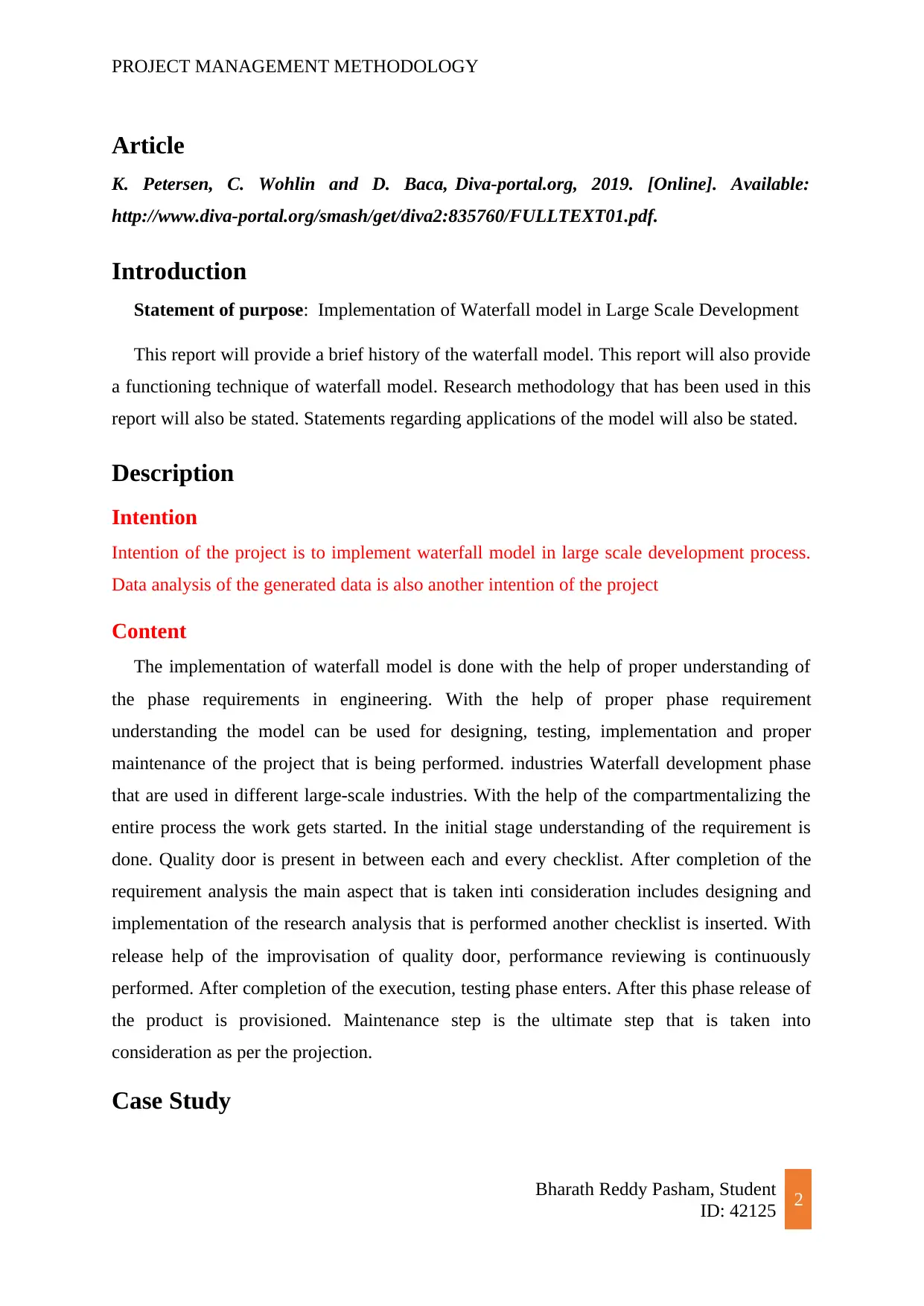
PROJECT MANAGEMENT METHODOLOGY
Article
K. Petersen, C. Wohlin and D. Baca, Diva-portal.org, 2019. [Online]. Available:
http://www.diva-portal.org/smash/get/diva2:835760/FULLTEXT01.pdf.
Introduction
Statement of purpose: Implementation of Waterfall model in Large Scale Development
This report will provide a brief history of the waterfall model. This report will also provide
a functioning technique of waterfall model. Research methodology that has been used in this
report will also be stated. Statements regarding applications of the model will also be stated.
Description
Intention
Intention of the project is to implement waterfall model in large scale development process.
Data analysis of the generated data is also another intention of the project
Content
The implementation of waterfall model is done with the help of proper understanding of
the phase requirements in engineering. With the help of proper phase requirement
understanding the model can be used for designing, testing, implementation and proper
maintenance of the project that is being performed. industries Waterfall development phase
that are used in different large-scale industries. With the help of the compartmentalizing the
entire process the work gets started. In the initial stage understanding of the requirement is
done. Quality door is present in between each and every checklist. After completion of the
requirement analysis the main aspect that is taken inti consideration includes designing and
implementation of the research analysis that is performed another checklist is inserted. With
release help of the improvisation of quality door, performance reviewing is continuously
performed. After completion of the execution, testing phase enters. After this phase release of
the product is provisioned. Maintenance step is the ultimate step that is taken into
consideration as per the projection.
Case Study
Bharath Reddy Pasham, Student
ID: 42125 2
Article
K. Petersen, C. Wohlin and D. Baca, Diva-portal.org, 2019. [Online]. Available:
http://www.diva-portal.org/smash/get/diva2:835760/FULLTEXT01.pdf.
Introduction
Statement of purpose: Implementation of Waterfall model in Large Scale Development
This report will provide a brief history of the waterfall model. This report will also provide
a functioning technique of waterfall model. Research methodology that has been used in this
report will also be stated. Statements regarding applications of the model will also be stated.
Description
Intention
Intention of the project is to implement waterfall model in large scale development process.
Data analysis of the generated data is also another intention of the project
Content
The implementation of waterfall model is done with the help of proper understanding of
the phase requirements in engineering. With the help of proper phase requirement
understanding the model can be used for designing, testing, implementation and proper
maintenance of the project that is being performed. industries Waterfall development phase
that are used in different large-scale industries. With the help of the compartmentalizing the
entire process the work gets started. In the initial stage understanding of the requirement is
done. Quality door is present in between each and every checklist. After completion of the
requirement analysis the main aspect that is taken inti consideration includes designing and
implementation of the research analysis that is performed another checklist is inserted. With
release help of the improvisation of quality door, performance reviewing is continuously
performed. After completion of the execution, testing phase enters. After this phase release of
the product is provisioned. Maintenance step is the ultimate step that is taken into
consideration as per the projection.
Case Study
Bharath Reddy Pasham, Student
ID: 42125 2
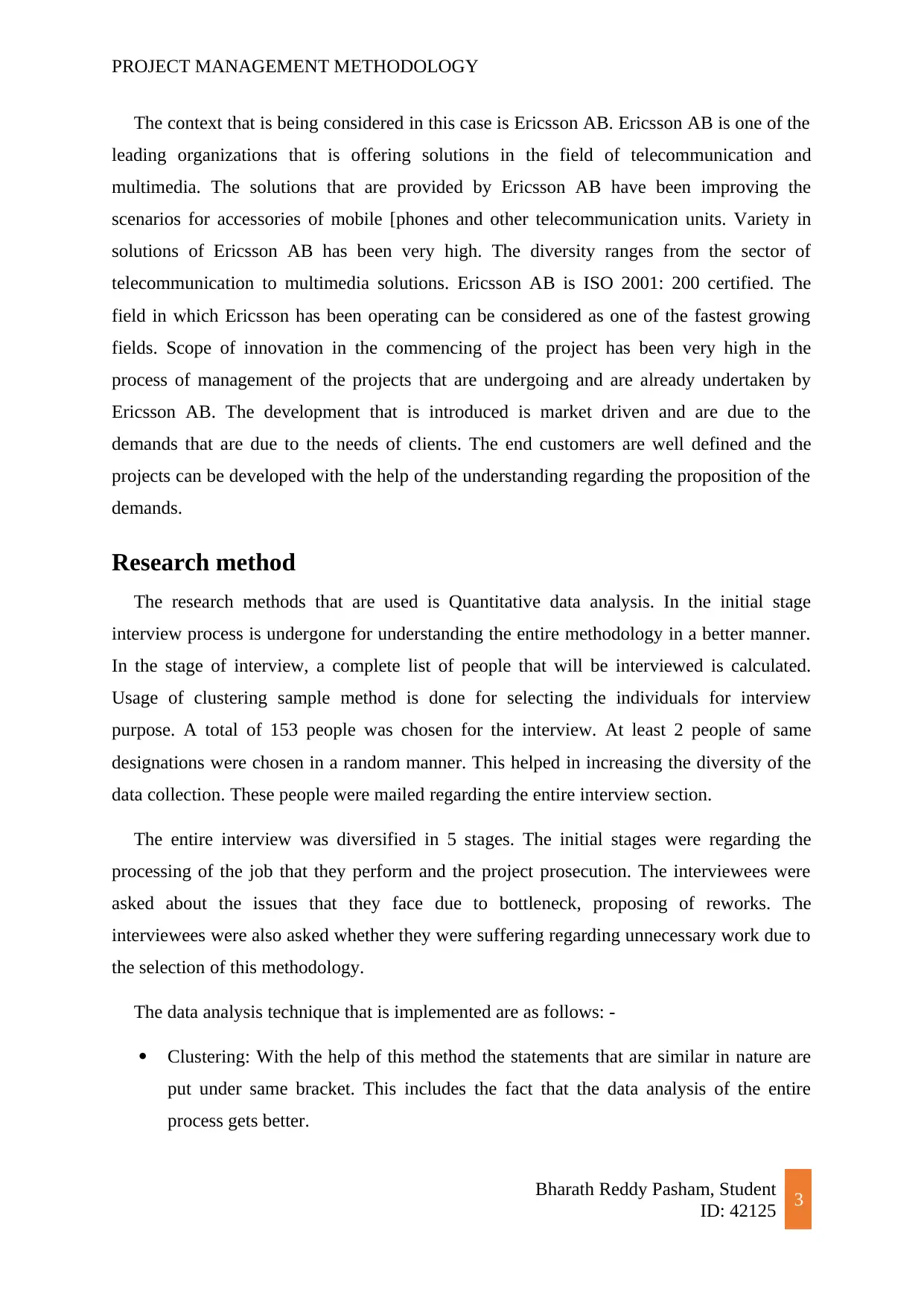
PROJECT MANAGEMENT METHODOLOGY
The context that is being considered in this case is Ericsson AB. Ericsson AB is one of the
leading organizations that is offering solutions in the field of telecommunication and
multimedia. The solutions that are provided by Ericsson AB have been improving the
scenarios for accessories of mobile [phones and other telecommunication units. Variety in
solutions of Ericsson AB has been very high. The diversity ranges from the sector of
telecommunication to multimedia solutions. Ericsson AB is ISO 2001: 200 certified. The
field in which Ericsson has been operating can be considered as one of the fastest growing
fields. Scope of innovation in the commencing of the project has been very high in the
process of management of the projects that are undergoing and are already undertaken by
Ericsson AB. The development that is introduced is market driven and are due to the
demands that are due to the needs of clients. The end customers are well defined and the
projects can be developed with the help of the understanding regarding the proposition of the
demands.
Research method
The research methods that are used is Quantitative data analysis. In the initial stage
interview process is undergone for understanding the entire methodology in a better manner.
In the stage of interview, a complete list of people that will be interviewed is calculated.
Usage of clustering sample method is done for selecting the individuals for interview
purpose. A total of 153 people was chosen for the interview. At least 2 people of same
designations were chosen in a random manner. This helped in increasing the diversity of the
data collection. These people were mailed regarding the entire interview section.
The entire interview was diversified in 5 stages. The initial stages were regarding the
processing of the job that they perform and the project prosecution. The interviewees were
asked about the issues that they face due to bottleneck, proposing of reworks. The
interviewees were also asked whether they were suffering regarding unnecessary work due to
the selection of this methodology.
The data analysis technique that is implemented are as follows: -
Clustering: With the help of this method the statements that are similar in nature are
put under same bracket. This includes the fact that the data analysis of the entire
process gets better.
Bharath Reddy Pasham, Student
ID: 42125 3
The context that is being considered in this case is Ericsson AB. Ericsson AB is one of the
leading organizations that is offering solutions in the field of telecommunication and
multimedia. The solutions that are provided by Ericsson AB have been improving the
scenarios for accessories of mobile [phones and other telecommunication units. Variety in
solutions of Ericsson AB has been very high. The diversity ranges from the sector of
telecommunication to multimedia solutions. Ericsson AB is ISO 2001: 200 certified. The
field in which Ericsson has been operating can be considered as one of the fastest growing
fields. Scope of innovation in the commencing of the project has been very high in the
process of management of the projects that are undergoing and are already undertaken by
Ericsson AB. The development that is introduced is market driven and are due to the
demands that are due to the needs of clients. The end customers are well defined and the
projects can be developed with the help of the understanding regarding the proposition of the
demands.
Research method
The research methods that are used is Quantitative data analysis. In the initial stage
interview process is undergone for understanding the entire methodology in a better manner.
In the stage of interview, a complete list of people that will be interviewed is calculated.
Usage of clustering sample method is done for selecting the individuals for interview
purpose. A total of 153 people was chosen for the interview. At least 2 people of same
designations were chosen in a random manner. This helped in increasing the diversity of the
data collection. These people were mailed regarding the entire interview section.
The entire interview was diversified in 5 stages. The initial stages were regarding the
processing of the job that they perform and the project prosecution. The interviewees were
asked about the issues that they face due to bottleneck, proposing of reworks. The
interviewees were also asked whether they were suffering regarding unnecessary work due to
the selection of this methodology.
The data analysis technique that is implemented are as follows: -
Clustering: With the help of this method the statements that are similar in nature are
put under same bracket. This includes the fact that the data analysis of the entire
process gets better.
Bharath Reddy Pasham, Student
ID: 42125 3
⊘ This is a preview!⊘
Do you want full access?
Subscribe today to unlock all pages.

Trusted by 1+ million students worldwide
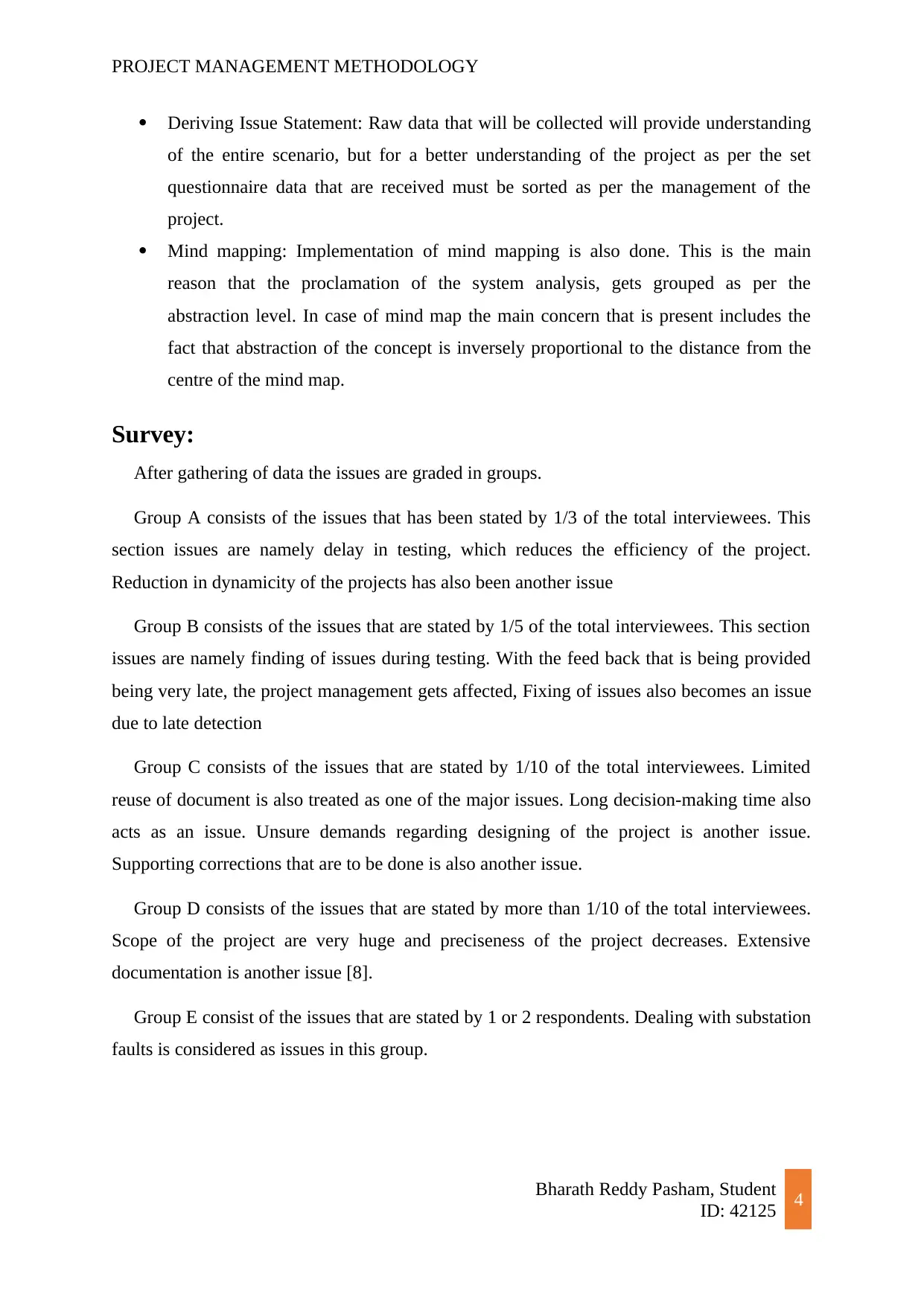
PROJECT MANAGEMENT METHODOLOGY
Deriving Issue Statement: Raw data that will be collected will provide understanding
of the entire scenario, but for a better understanding of the project as per the set
questionnaire data that are received must be sorted as per the management of the
project.
Mind mapping: Implementation of mind mapping is also done. This is the main
reason that the proclamation of the system analysis, gets grouped as per the
abstraction level. In case of mind map the main concern that is present includes the
fact that abstraction of the concept is inversely proportional to the distance from the
centre of the mind map.
Survey:
After gathering of data the issues are graded in groups.
Group A consists of the issues that has been stated by 1/3 of the total interviewees. This
section issues are namely delay in testing, which reduces the efficiency of the project.
Reduction in dynamicity of the projects has also been another issue
Group B consists of the issues that are stated by 1/5 of the total interviewees. This section
issues are namely finding of issues during testing. With the feed back that is being provided
being very late, the project management gets affected, Fixing of issues also becomes an issue
due to late detection
Group C consists of the issues that are stated by 1/10 of the total interviewees. Limited
reuse of document is also treated as one of the major issues. Long decision-making time also
acts as an issue. Unsure demands regarding designing of the project is another issue.
Supporting corrections that are to be done is also another issue.
Group D consists of the issues that are stated by more than 1/10 of the total interviewees.
Scope of the project are very huge and preciseness of the project decreases. Extensive
documentation is another issue [8].
Group E consist of the issues that are stated by 1 or 2 respondents. Dealing with substation
faults is considered as issues in this group.
Bharath Reddy Pasham, Student
ID: 42125 4
Deriving Issue Statement: Raw data that will be collected will provide understanding
of the entire scenario, but for a better understanding of the project as per the set
questionnaire data that are received must be sorted as per the management of the
project.
Mind mapping: Implementation of mind mapping is also done. This is the main
reason that the proclamation of the system analysis, gets grouped as per the
abstraction level. In case of mind map the main concern that is present includes the
fact that abstraction of the concept is inversely proportional to the distance from the
centre of the mind map.
Survey:
After gathering of data the issues are graded in groups.
Group A consists of the issues that has been stated by 1/3 of the total interviewees. This
section issues are namely delay in testing, which reduces the efficiency of the project.
Reduction in dynamicity of the projects has also been another issue
Group B consists of the issues that are stated by 1/5 of the total interviewees. This section
issues are namely finding of issues during testing. With the feed back that is being provided
being very late, the project management gets affected, Fixing of issues also becomes an issue
due to late detection
Group C consists of the issues that are stated by 1/10 of the total interviewees. Limited
reuse of document is also treated as one of the major issues. Long decision-making time also
acts as an issue. Unsure demands regarding designing of the project is another issue.
Supporting corrections that are to be done is also another issue.
Group D consists of the issues that are stated by more than 1/10 of the total interviewees.
Scope of the project are very huge and preciseness of the project decreases. Extensive
documentation is another issue [8].
Group E consist of the issues that are stated by 1 or 2 respondents. Dealing with substation
faults is considered as issues in this group.
Bharath Reddy Pasham, Student
ID: 42125 4
Paraphrase This Document
Need a fresh take? Get an instant paraphrase of this document with our AI Paraphraser
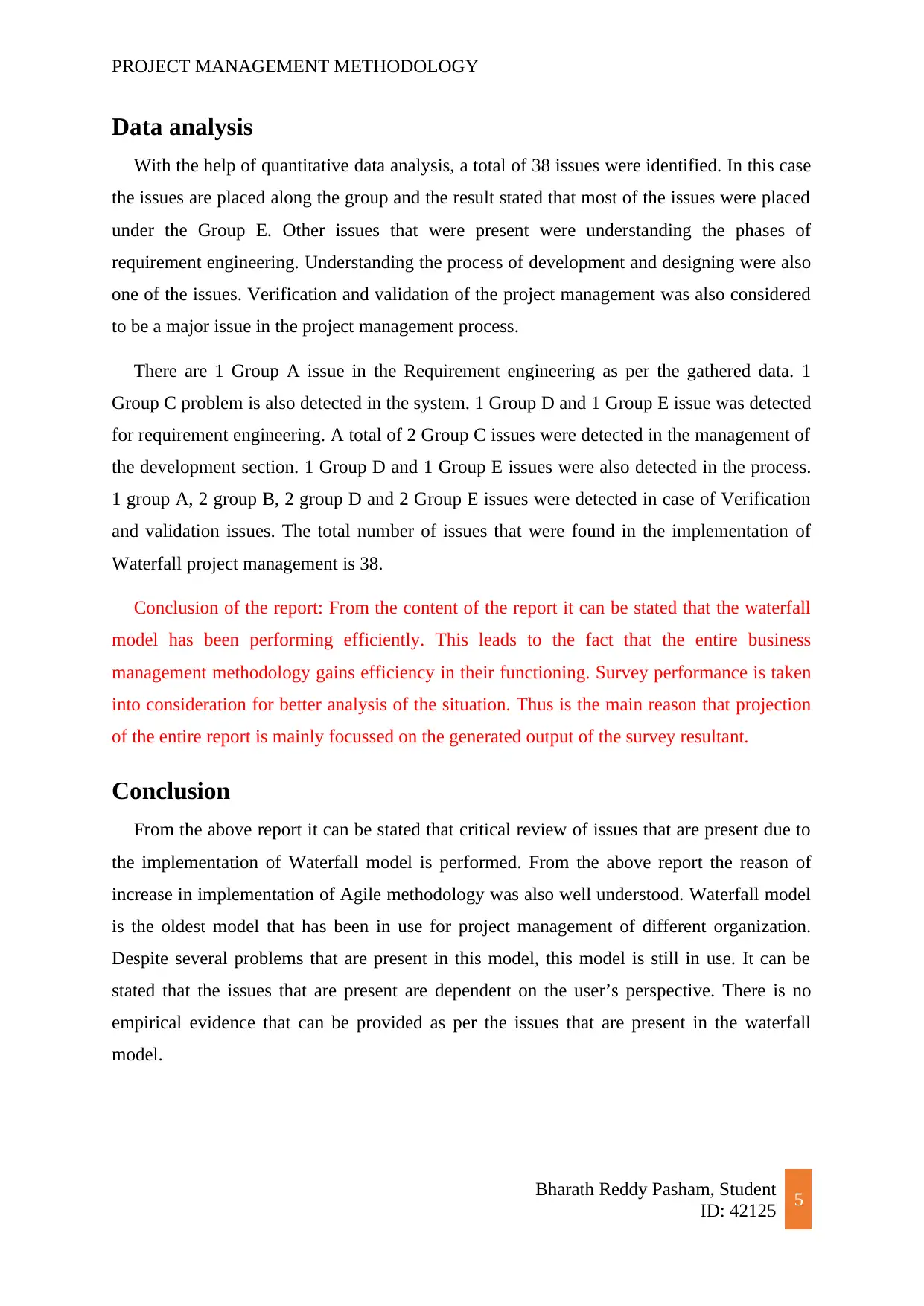
PROJECT MANAGEMENT METHODOLOGY
Data analysis
With the help of quantitative data analysis, a total of 38 issues were identified. In this case
the issues are placed along the group and the result stated that most of the issues were placed
under the Group E. Other issues that were present were understanding the phases of
requirement engineering. Understanding the process of development and designing were also
one of the issues. Verification and validation of the project management was also considered
to be a major issue in the project management process.
There are 1 Group A issue in the Requirement engineering as per the gathered data. 1
Group C problem is also detected in the system. 1 Group D and 1 Group E issue was detected
for requirement engineering. A total of 2 Group C issues were detected in the management of
the development section. 1 Group D and 1 Group E issues were also detected in the process.
1 group A, 2 group B, 2 group D and 2 Group E issues were detected in case of Verification
and validation issues. The total number of issues that were found in the implementation of
Waterfall project management is 38.
Conclusion of the report: From the content of the report it can be stated that the waterfall
model has been performing efficiently. This leads to the fact that the entire business
management methodology gains efficiency in their functioning. Survey performance is taken
into consideration for better analysis of the situation. Thus is the main reason that projection
of the entire report is mainly focussed on the generated output of the survey resultant.
Conclusion
From the above report it can be stated that critical review of issues that are present due to
the implementation of Waterfall model is performed. From the above report the reason of
increase in implementation of Agile methodology was also well understood. Waterfall model
is the oldest model that has been in use for project management of different organization.
Despite several problems that are present in this model, this model is still in use. It can be
stated that the issues that are present are dependent on the user’s perspective. There is no
empirical evidence that can be provided as per the issues that are present in the waterfall
model.
Bharath Reddy Pasham, Student
ID: 42125 5
Data analysis
With the help of quantitative data analysis, a total of 38 issues were identified. In this case
the issues are placed along the group and the result stated that most of the issues were placed
under the Group E. Other issues that were present were understanding the phases of
requirement engineering. Understanding the process of development and designing were also
one of the issues. Verification and validation of the project management was also considered
to be a major issue in the project management process.
There are 1 Group A issue in the Requirement engineering as per the gathered data. 1
Group C problem is also detected in the system. 1 Group D and 1 Group E issue was detected
for requirement engineering. A total of 2 Group C issues were detected in the management of
the development section. 1 Group D and 1 Group E issues were also detected in the process.
1 group A, 2 group B, 2 group D and 2 Group E issues were detected in case of Verification
and validation issues. The total number of issues that were found in the implementation of
Waterfall project management is 38.
Conclusion of the report: From the content of the report it can be stated that the waterfall
model has been performing efficiently. This leads to the fact that the entire business
management methodology gains efficiency in their functioning. Survey performance is taken
into consideration for better analysis of the situation. Thus is the main reason that projection
of the entire report is mainly focussed on the generated output of the survey resultant.
Conclusion
From the above report it can be stated that critical review of issues that are present due to
the implementation of Waterfall model is performed. From the above report the reason of
increase in implementation of Agile methodology was also well understood. Waterfall model
is the oldest model that has been in use for project management of different organization.
Despite several problems that are present in this model, this model is still in use. It can be
stated that the issues that are present are dependent on the user’s perspective. There is no
empirical evidence that can be provided as per the issues that are present in the waterfall
model.
Bharath Reddy Pasham, Student
ID: 42125 5
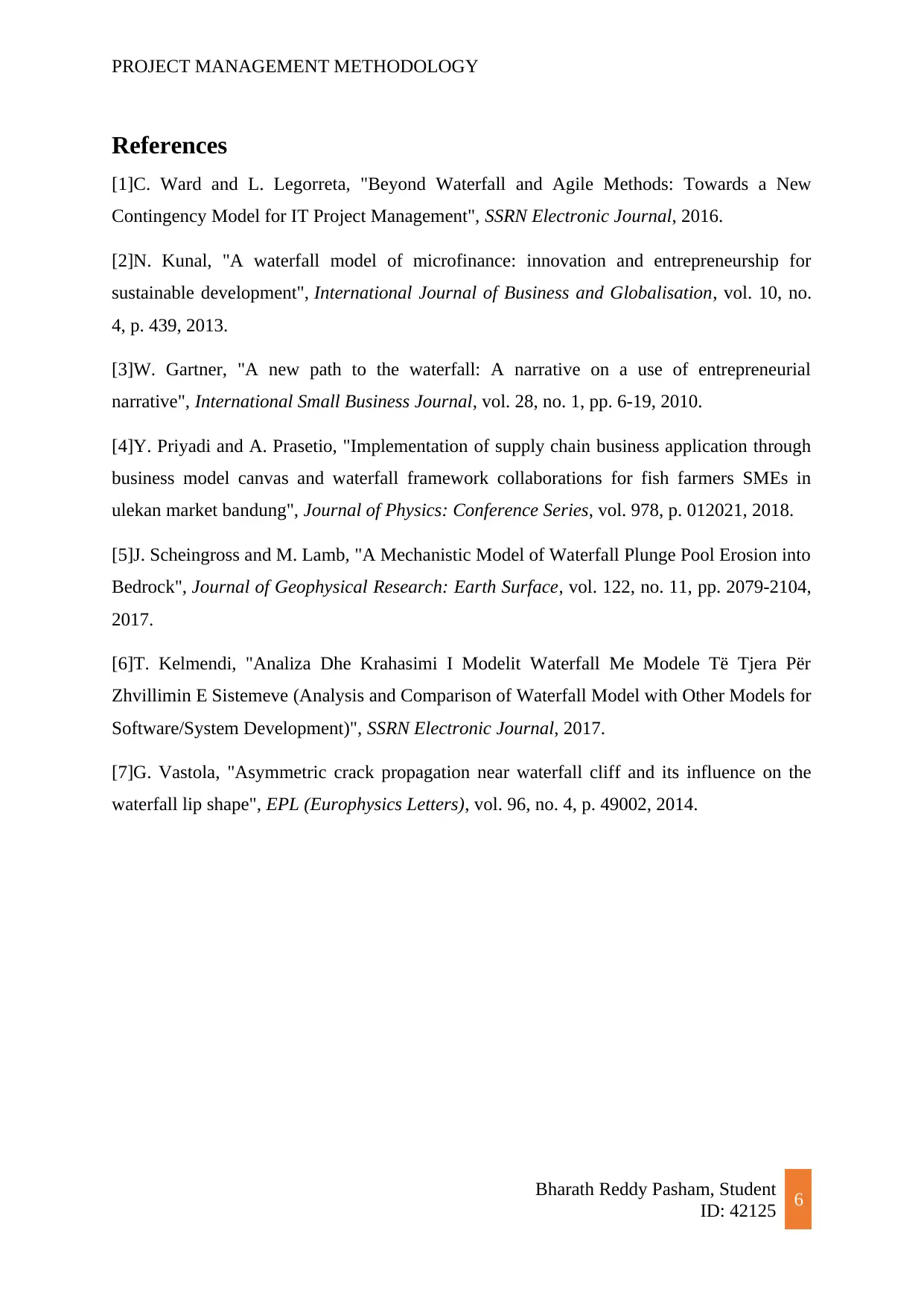
PROJECT MANAGEMENT METHODOLOGY
References
[1]C. Ward and L. Legorreta, "Beyond Waterfall and Agile Methods: Towards a New
Contingency Model for IT Project Management", SSRN Electronic Journal, 2016.
[2]N. Kunal, "A waterfall model of microfinance: innovation and entrepreneurship for
sustainable development", International Journal of Business and Globalisation, vol. 10, no.
4, p. 439, 2013.
[3]W. Gartner, "A new path to the waterfall: A narrative on a use of entrepreneurial
narrative", International Small Business Journal, vol. 28, no. 1, pp. 6-19, 2010.
[4]Y. Priyadi and A. Prasetio, "Implementation of supply chain business application through
business model canvas and waterfall framework collaborations for fish farmers SMEs in
ulekan market bandung", Journal of Physics: Conference Series, vol. 978, p. 012021, 2018.
[5]J. Scheingross and M. Lamb, "A Mechanistic Model of Waterfall Plunge Pool Erosion into
Bedrock", Journal of Geophysical Research: Earth Surface, vol. 122, no. 11, pp. 2079-2104,
2017.
[6]T. Kelmendi, "Analiza Dhe Krahasimi I Modelit Waterfall Me Modele Të Tjera Për
Zhvillimin E Sistemeve (Analysis and Comparison of Waterfall Model with Other Models for
Software/System Development)", SSRN Electronic Journal, 2017.
[7]G. Vastola, "Asymmetric crack propagation near waterfall cliff and its influence on the
waterfall lip shape", EPL (Europhysics Letters), vol. 96, no. 4, p. 49002, 2014.
Bharath Reddy Pasham, Student
ID: 42125 6
References
[1]C. Ward and L. Legorreta, "Beyond Waterfall and Agile Methods: Towards a New
Contingency Model for IT Project Management", SSRN Electronic Journal, 2016.
[2]N. Kunal, "A waterfall model of microfinance: innovation and entrepreneurship for
sustainable development", International Journal of Business and Globalisation, vol. 10, no.
4, p. 439, 2013.
[3]W. Gartner, "A new path to the waterfall: A narrative on a use of entrepreneurial
narrative", International Small Business Journal, vol. 28, no. 1, pp. 6-19, 2010.
[4]Y. Priyadi and A. Prasetio, "Implementation of supply chain business application through
business model canvas and waterfall framework collaborations for fish farmers SMEs in
ulekan market bandung", Journal of Physics: Conference Series, vol. 978, p. 012021, 2018.
[5]J. Scheingross and M. Lamb, "A Mechanistic Model of Waterfall Plunge Pool Erosion into
Bedrock", Journal of Geophysical Research: Earth Surface, vol. 122, no. 11, pp. 2079-2104,
2017.
[6]T. Kelmendi, "Analiza Dhe Krahasimi I Modelit Waterfall Me Modele Të Tjera Për
Zhvillimin E Sistemeve (Analysis and Comparison of Waterfall Model with Other Models for
Software/System Development)", SSRN Electronic Journal, 2017.
[7]G. Vastola, "Asymmetric crack propagation near waterfall cliff and its influence on the
waterfall lip shape", EPL (Europhysics Letters), vol. 96, no. 4, p. 49002, 2014.
Bharath Reddy Pasham, Student
ID: 42125 6
⊘ This is a preview!⊘
Do you want full access?
Subscribe today to unlock all pages.

Trusted by 1+ million students worldwide
1 out of 6
Related Documents
Your All-in-One AI-Powered Toolkit for Academic Success.
+13062052269
info@desklib.com
Available 24*7 on WhatsApp / Email
![[object Object]](/_next/static/media/star-bottom.7253800d.svg)
Unlock your academic potential
Copyright © 2020–2025 A2Z Services. All Rights Reserved. Developed and managed by ZUCOL.



